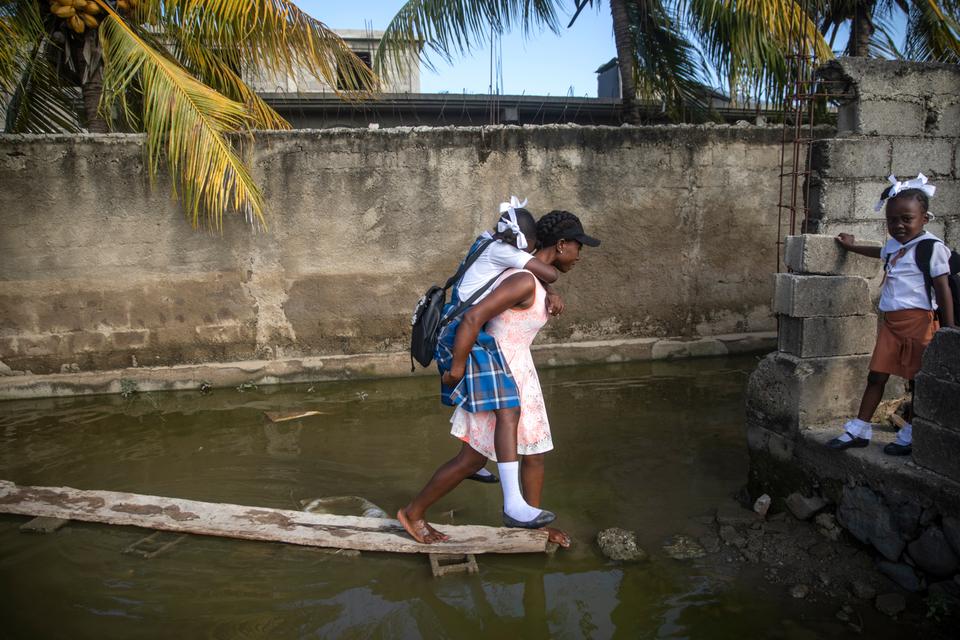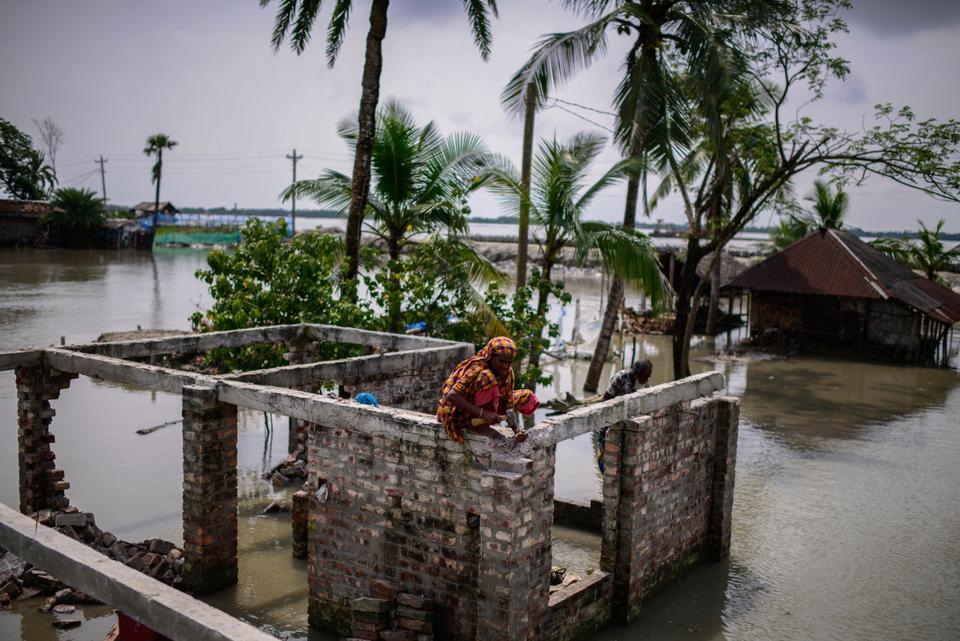Climate-vulnerable nations, already footing the global bill of a changing climate, face rising borrowing costs and economic challenges that further impair their ability to adapt.
Due to their geographical location and size, the Caribbean islands have long been among the most vulnerable to climate change: rising sea levels, longer dry seasons and stronger hurricanes continue to affect food security and cause mass displacement, just as the world grapples with successive economic crises.
As the Ukraine war enters its sixth month, its economic repercussions are felt as far as Haiti or Belize, but also in small island states in the Pacific that are increasingly threatened by uninhabitability. Regardless of their direct dependence on either Ukraine or Russia for food security, low and middle income countries increasingly grapple with a spiralling debt burden that, in turn, is set to further hinder their ability to adapt to a changing climate.
“[These] governments have largely been bankrolling or paying for their adaptation,” Janine Felson, Belize ambassador and co-lead Climate Finance Negotiator at the Alliance of Small Island States (AOSIS), told TRT World.
“They will have to take a bit of a pain killer to swallow the cost,” Felson says, “which means that national budgets will have to be used to either reduce taxes on imports for fuels or to manage social support systems,” she adds.
In Belize, for instance, it is estimated that climate change impacts cost a staggering 7 percent of GDP, far exceeding even the best years of economic growth.
“With climate events all but certain to worsen as global warming continues its upward trajectory, the costs of living with climate will only continue to increase,” Felson adds.
“The inverse relationship of those costs to economic growth, coupled with lack of access to concessional financing for Caribbean islands, means that the Caribbean is essentially bankrolling the dirty habits of a handful of polluters,” Felson says.
A recent report found that eleven African countries that are among the least historically responsible for climate change have to spend the most to adapt to it - in some cases spending up to five times more on adaptation than they do on healthcare. Eritrea, for instance, is expected to face climate adaptation costs amounting to 22.7 percent of its GDP, compared with 4.46 percent it spends on healthcare.
The Russia-Ukraine conflict has sent international prices for energy, food and fertilizer soaring, affecting the world’s poorest countries most. Wheat shortages have affected countries like Sudan, Congo, Somalia, Benin, Laos and Senegal, dependent on Russia and Ukraine for two thirds or more of their imports. A surge in fertilizer costs linked to higher gas prices has added pressure on farmers all over the world, even more so in countries ravaged by multiple crises.
In 2009, rich nations pledged to provide $100BN a year from 2020 to 2025 to low-income countries to help them fund their climate adaptation and mitigation goals. Climate mitigation refers to efforts to reduce greenhouse gas emissions, such as developing renewable energy sources. Adaptation refers to what is being done in order to prevent the worst impact of those effects, including capturing sea water for irrigation or building new flood defenses.
Official OECD figures show that target has gone unmet – the last available figures for 2019 indicate a shortfall of $20bn. Critics also point out that the majority of climate finance is provided in the form of loans rather than grants. Among others, a 2020 Oxfam report shows how climate finance does not reach those most in need, and when it does, it is on ungenerous terms. In other words, the poorest end up shouldering the costs of climate change.
“The African continent only received $18.3BN in climate finance annually between 2006 and 2019,” Professor Kevin Urama, acting chief economist and vice president at the African Development Bank Group told TRT World.
“And that includes financing from these governments themselves,” he explains, “so if you look at the true climate external finance, that figure is even lower.” Yet, Urama says, the continent needs over $128 billion annually to meet the overall goals of its climate action plan, also known as Nationally Determined Contributions, as set out in the Paris Agreement.

Rising debt
A study by the Overseas Development Institute (ODI) looking into the economic costs of the war in Ukraine on low and middle-income countries shows that many countries not directly economically exposed are among the most impacted by the global economic shock.
“One of the indicators that we used was debt distress,” Laetitia Pettinotti, one of the study’s authors, told TRT World, pointing out that small island nations, for instance, appear to be over-represented among the top losers.
“These are countries that are even more stuck between the inability to borrow, increasing climate risk, and lower capacity to finance adaptation.”
“Climate finance is not what is causing their debt distress, but it adds further inequity,” Pettinotti adds.
In addition, as wealthy countries deal with the increased cost of living for their citizens at home, development aid – of which climate finance is part - is at further risk of being scaled back. The United Kingdom, for one, has announced cuts to its budget.
“Whilst there were lots of solutions being put on the table [at COP26] around indebtedness, emerging from a combination of climate impacts and Covid-19, the solutions aren't really bearing fruit,” Clare Shakya, climate change director at the International Institute for Environment and Development (IIED) told TRT World.
“It's insufficient to just keep talking about those solutions without making progress. This is massive, and it's exactly the wrong time for the UK to be putting a hold on spending.”

Footing the climate bill
The UN estimates that the amount required by developing countries each year to sustain the costs of mitigation and adaptation is likely to rise to $300BN by 2030. If mitigation targets are not met that figure could rise to up to $500 billion in 2050.
The war in Ukraine has sent gas prices through the roof, as well as European governments looking for alternative sources of energy as Russia turns off the gas tap to put pressure on western governments over sanctions. New deals that include the development of new gas infrastructure, and the reopening of coal power plants are set to be a massive setback for the bloc’s climate targets.
Meanwhile, as extreme weather events become more frequent across the world, the biggest brunt is borne by developing countries.
A recent Oxfam report estimates that the amount of funds needed for UN humanitarian appeals involving extreme weather events including floods and droughts is now eight times higher than it was 20 years ago. Donor countries, the report says, have only been footing half of that bill. The countries with the most recurrent appeals include Afghanistan, Burkina Faso, Burundi, Chad, Democratic Republic of the Congo, Haiti, Kenya, Niger, Somalia, South Sudan and Zimbabwe.
“The decline in climate finance can lead the world into a triple crisis,” Professor Urama says.
“When you have that triangle of disaster, poverty, unemployment and climate impacts, you can’t but find terrorism and conflicts and social fragility.”

Ylenia Gostoli
Social media is bold.
Social media is young.
Social media raises questions.
Social media is not satisfied with an answer.
Social media looks at the big picture.
Social media is interested in every detail.
social media is curious.
Social media is free.
Social media is irreplaceable.
But never irrelevant.
Social media is you.
(With input from news agency language)
If you like this story, share it with a friend!
We are a non-profit organization. Help us financially to keep our journalism free from government and corporate pressure














0 Comments